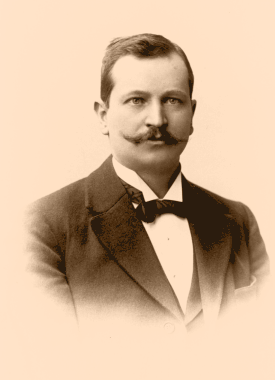
BIOGRAPHY OF PAUL DRUDE ( 1863 - 1906 )
-
born July. 12, 1863, Braunschweig , Germany.
died July 5, 1906, Berlin , Germany.
|
|
BIOGRAPHY OF PAUL DRUDE ( 1863 - 1906 )
died July 5, 1906, Berlin , Germany. |
Paul Karl Ludwig Drude (July 12, 1863 - July 5, 1906) was a German physicist specializing in optics. Known for the Drude model. He wrote a fundamental textbook integrating optics with Maxwell's theories of electromagnetism. He was born in Braunschweig, the son of a physician.
Drude began his studies in mathematics at the University of Go"ttingen, but later changed his major to physics. His dissertation covering the reflection and diffraction of light in crystals was completed in 1887, under Woldemar Voigt.
In 1894 Drude became an extraordinarius professor at the University of Leipzig; in the same year he married Emilie Regelsberger, daughter of a Go"ttingen lawyer. They had four children. In 1900, he became the editor for the scientific journal Annalen der Physik, the most respected physics journal at that time. From 1901-1905, he was ordinarius professor of physics at Giessen University. In 1905 he became the director of the physics institute of the University of Berlin. In 1906, at the height of his career, be became a member of the Prussian Academy of Sciences. A few days after his inauguration lecture, for inexplicable reasons, he committed suicide. Drude was survived by his wife and four children.
Paul Drude was a highly respected physicist. He performed pioneering work on the optics of absorbing media and connected the optical with the electrical and thermal properties of solids. His well-known textbook on optics (Lehrbuch der Optik, Leipzig, 1900) appeared for the first time in English in 1902 (Longmans, Green).
Drude graduated the year Heinrich Hertz began publishing his findings from his experiments on the electromagnetic theories of James Clerk Maxwell. Thus Drude began his professional career at the time Maxwell’s theories were being introduced into Germany. His first experiments were the determination of the optical constants of various solids, measured to unprecedented levels of accuracy. He then worked to derive relationships between the optical and electrical constants and the physical structure of substances. In 1894 he was responsible for introducing the symbol "c" for the speed of light in a perfect vacuum.
Toward the end of his tenure at Leipzig, Drude was invited to write a textbook on optics, which he accepted. The book, Lehrbuch der Optik, published in 1900, brought together the formerly distinct subjects of electricity and optics, which was cited by Drude as an “epoch-making advance in natural science.”
In 1900 he developed a powerful model to explain the thermal, electrical, and optical properties of matter. The Drude model would be further advanced in 1933 by Arnold Sommerfeld and Hans Bethe, becoming the Drude-Sommerfeld-Model.
The most important publications of Paul Drude are:
* Bestimmung der optischer Constanten der Metalle
Annalen der Physik und Chemie (Wiedemanns Annalen) 39, 481-554 (1890)
* Physik des Athers auf elektromagnetischer Grundlage
(Verlag F. Enke, Stuttgart, 1894)
* Winkelmanns Handbuch der Physik, Bd. II, Teil 1, Optik (1894)
* Zur Elektronentheorie der Metalle, I. Teil, II. Teil, und Berichtigung,
Annalen der Physik 1, 556-613 (1900); ibid 3, 369-402 (1900); ibid 7, 687-692 (1902)
* Optische Eigenschaften und Elektronentheorie, I. und II. Teil
Annalen der Physik 14, 667-725 and 936-961 (1904)
* Lehrbuch der Optik (textbook on optics)
1. Auflage (S. Hirzel, Leipzig, 1900)
There are a few places where the biography of PAUL DRUDE can be found.